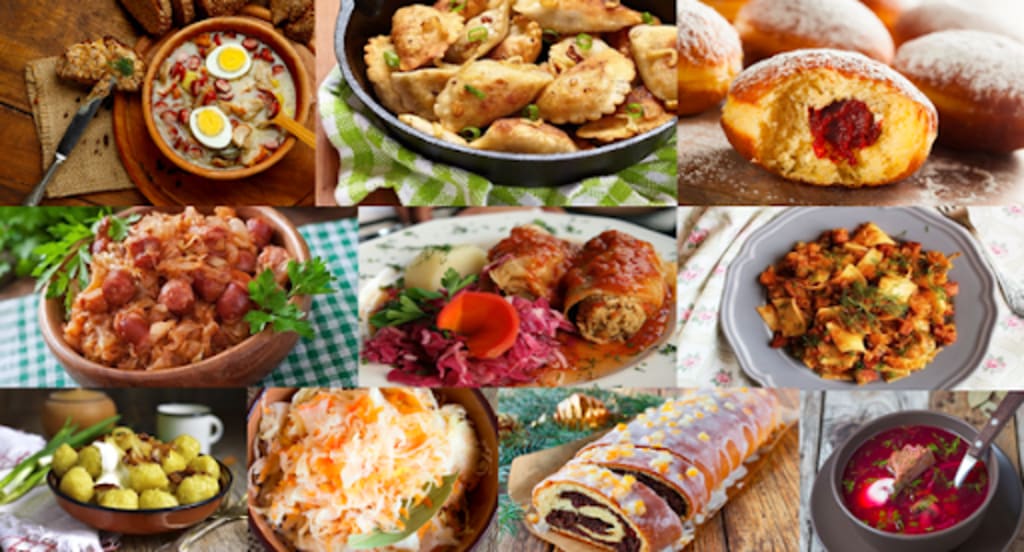Perogi!
The History of Food Culture in Poland

Poland has a rich food history and a great deal of influence on foods in surrounding countries. Old Polish (prior to the intrusion of Christianity in the 10th Century) cuisine has its roots in foods found from the forest- wild game, mushrooms, fruits, and herbs, and Poland’s geographical location affected its cuisine immensely. Since then, the food culture has evolved because of the influences of the Catholic Church. The institution of Christianity in Poland had an enormous impact on traditional Polish foods. In this essay I will explore the original Old Polish cuisine, and explain how the coming of Christianity in 996 A.D. and Poland’s geography have impacted food cultures in Poland.
Poland is located in North-Central Europe and borders the Baltic Sea, and today’s countries of Germany, Czech Republic, Slovakia, Ukraine, Belarus, Lithuania, and a small piece of Russia, and Poles as we know them came from their Slavic ancestors. Old Poland had foods based around groats and meats (especially pork), with sylvan edibles such as wild mushrooms often being incorporated. Interestingly, Poland still has a taste for wild mushrooms and is an outlier from other parts of Europe in this. Foods that were easily preserved prevailed, since the winters in Poland are cold and barren, therefore pickling, salting, fermenting, and drying were common. These food processes are still used in Polish cuisine to this day. The location of Poland along the Baltic Sea meant that in the old days Poland enjoyed saltwater fish such as herring. Unfortunately due to the many wars in its history access to the Sea was limited much of the time, so instead Poles looked to freshwater fish which became a large part of its food culture. Poland had the luxury of getting spices cheaper than other parts of Europe due to “close trade relations between Poland and countries of the Orient” (Tasting Poland) and therefore Polish food was known for being pungent and using large amounts of salt and other seasonings as compared to some of its European neighbors. Poland in the Middle Ages had many dense forests, so hunting was a staple to get meat on the table. Forest fruits such as strawberries, black raspberries, blueberries, and currents were commonly used then and still are to this day.
Around 900 A.D. Christianity started to come into Poland, and today 95% of Polish are Roman Catholics. Christianity was officially adopted in 996 A.D., and it had a tremendous impact on Polish foods. Refraining from eating meat during specific times, fasting, banning dairy and eggs for religious reasons…all played a part in the culture of meals and foods in Poland changing the cuisine into how we know it today. “The Roman Catholic Church by enforcing fasts is responsible for spreading of eating fish and rising vegetarian traditional dishes” (Tasting Poland). So here we have a country that traditionally based its diet on wild game, groats, and forest edibles changing into a more agricultural era with strict religious food traditions. In the Middle Ages, the Roman Catholic Church had much harsher punishments for breaking a religious taboo, and much stricter requirements for observing the Holy days. Fasting was one way the Catholics influenced the diets of the Poles. During Lent one was forbidden to eat meat, eggs, or dairy, and Lent in the Middle Ages could last up to nine weeks. This gave rise to meatless dishes and a higher consumption of freshwater fish. On Christmas Eve fish became the traditional dish, and one particular recipe made Polish cuisine famous in Europe.
“Pike á la polonaise was a delight which made old Polish cuisine famous in Europe. The recipe was cited in cookbooks of various countries between the 16th and 18th centuries, e.g. in the Czech Kucharstvo, in a German cookbook by Anna Wecker (end of the 16th century), and in the 17th century in French and Austrian cookbooks” (Kasprzyk-Chevriaux 2016).
Today fasting is a tradition that has persisted and is done on Lent, Christmas Eve, and sometimes even on Fridays.
Also coming with Catholicism were religious holidays where enormous feasts were offered. Even in the homes of peasants, beautiful embroidered table cloths, decorative bowls, and other special tableware were brought out during the holidays. In the higher reaches of society gold and silver, tableware might be used, and there could be entertainment in the form of music and stories. Mead was a traditional drink during many of these feasts, and mead is still popular in Poland, as is vodka, and beer. Poland today is one of the “largest beer producers in Europe and a beer consumer in Poland drinks 92 liters of beer annually” (Nag, 2017). A tradition that is so popular that it has become ingrained in certain areas even here in the U.S. because of Polish immigrants is the Paczki. The Paczki has its roots in the Middle Ages and the coming of Christianity as well. They are a calorie-dense fried dough ball, originally filled with pork fat, but are now more like a doughnut and generally filled with fruit or cream. In Poland, they are eaten on Fat Thursday- in the U.S. they are eaten on Fat Tuesday. These days are significant because they are before the fasting of Lent and it was forbidden to eat them during Lent.
“In Old Poland, the zapusty or “carnival season” reached its height during this period. Elegant balls were held in well-to-do manor houses, attended by young men, women, and their parents. Country folk, on the other hand, would make merry, drink, dance, and flirt at the village inn. The rich would feast on fancy hors d’oeuvres, roast game, and fine wines. Peasants enjoyed their zimne noge (jellied pig’s knuckles), kiszka (blood and groat sausage), and kielbasa z kapusta (sausage and cabbage), which they washed down with beer and gorzalka, the least expensive vodka available. Common to both groups, however, were pączki, which were consumed in huge quantities” (Polish American Journal).
Because of large Polish immigrant communities here in the U.S., there are even festivals dedicated to the Paczki, one being the Annual Paczki Day Parade in Hamtramck, Michigan.
The regions around Poland are also responsible for some of its cuisine, and vice versa. Food markets became commonplace during the Middle Ages, and many culinary traits were exchanged with bordering peoples. If one visits the region today you will find similar styles of food in surrounding Germany, Slovakia, and Hungary, even food with the same name but regional variations. A perfect example is Gulasz, which originated in Hungary as Gulyas, and in Slovakian it is called Gulášová. Almost all forms are a soup or stew with a meat and tomato base, but depending on which country you are in your goulash (English spelling) might have noodles, or dumplings, peppers, be thick, or very brothy. Hunter’s Stew, or bigos, is a traditional Polish dish containing meat and sauerkraut, cabbage, spices, and wine and has been around since at least the 17th Century. It is quintessentially Polish with its strong spices, meat, and cabbage and was eaten by Polish nobility. Variations of it can now be found in Belarus, Lithuania, and Ukraine.
Ultimately the cuisine we see in Poland today has ancient roots, but has been modified and extrapolated upon by Christianity, geography, spice trade, and the influence of neighboring countries. Catholicism in particular brought significant change to the traditional hunter-gatherer cuisine, bringing Poland a new religion and with it new ideas and views about food. From fasting to gorging on Paczki, elaborate feasts to Lent, one can see the impact that Christianity in addition to geography had on the Polish meals eaten today.
References
History of Polish Food and Cuisine- Old Polisj Traditions. (n.d.). Retrieved from Tasting Poland: https://www.tastingpoland.com/food/old_polish_cuisine.html
Kasprzyk-Chevriaux, M. (2016, December 1). Not Just Carp & Herring: Traditional Polish Recipes for Fish. Retrieved from Culyure.Pl: https://culture.pl/en/article/not-just-carp-herring-traditional-polish-recipes-for-fish
Nag, O. S. (2017, August 1). The Culture of Poland. Retrieved from World Atlas: https://www.worldatlas.com/articles/the-culture-of-poland.html
unknown. (n.d.). Paczki Day. Retrieved from Polish American Journal: https://www.polamjournal.com/Library/Holidays/paczki/paczki.html
About the Creator
Amanda Bonesteel
Full-time college student. National and International volunteer. Researcher. Backpacker. Former wildland firefighter, AmeriCorps crew leader, and restaurant manager.
But importantly....avid science-fantasy enthusiast!






Comments
There are no comments for this story
Be the first to respond and start the conversation.